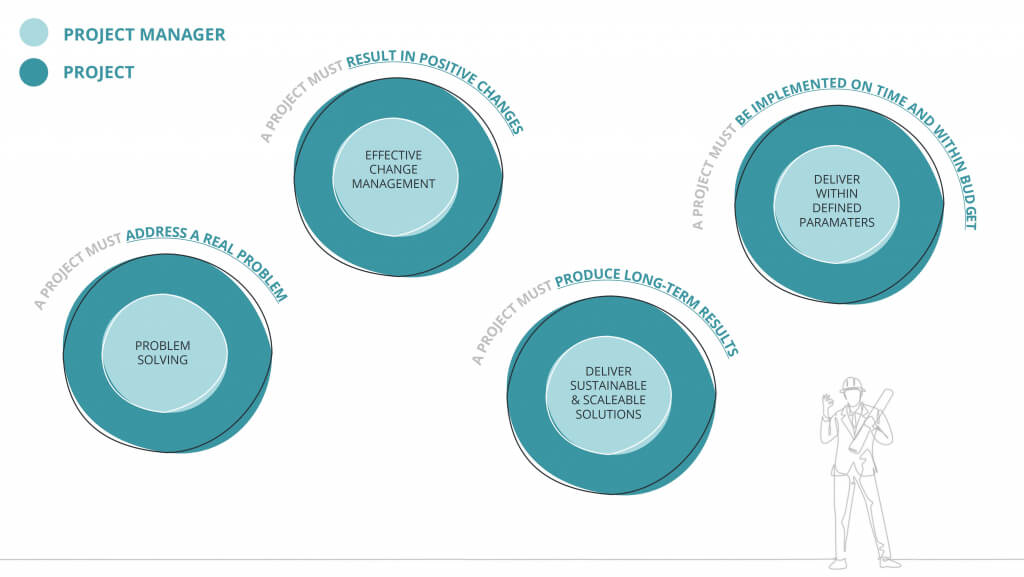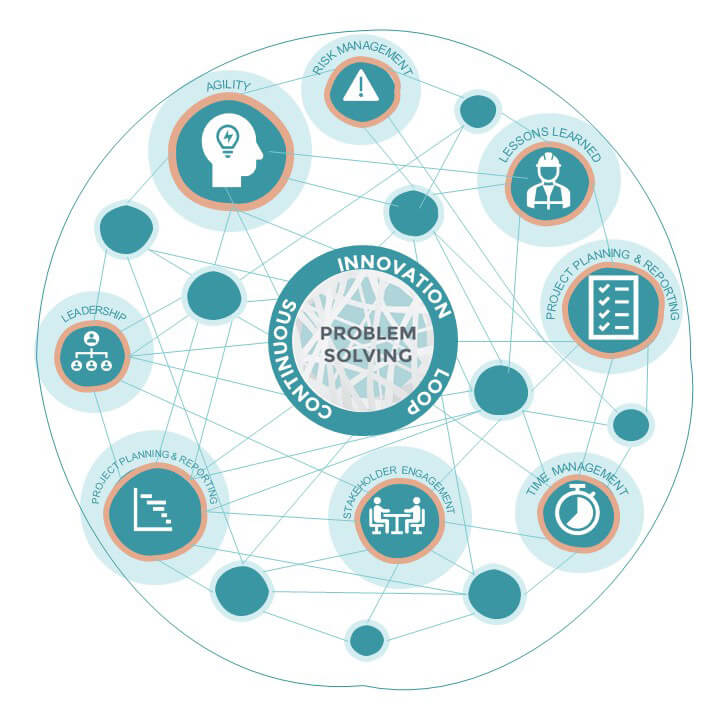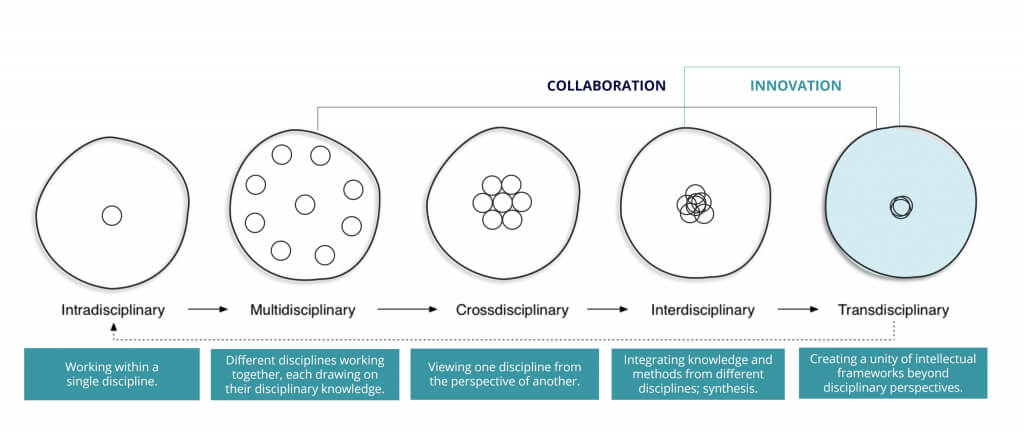The DNA of the Fit-for-Future Project Manager
11th December 2023
Project professionals tackle complex problems daily. These problems require different ways of thinking.
As project managers, we need to be equipped to manage and innovate in the project environment. We need to be prepared to think about how we can be disruptive innovators, change-makers and fit-for-future project managers.
Note: In this article, the term ‘Project Manager’ is applied to a holistic project professional on an infrastructure project. They may be a typical project manager or a technical and engineering manager, interface and integration manager, property manager, construction manager, placemaking or asset manager, risk, schedule, cost, change control manager, safety manager… including more managerial roles that do not currently exist yet.
Speculative Future
Let’s imagine a speculative future: What if the end of project management is near?
A speculative future is a design approach that helps us visualise new and potential worlds that could one day be reality. A speculative future may be utopian or dystopian. As a dystopian disruption, we can explore how the extinction of the project manager may impact the planning, delivery and operation of infrastructure projects across the nation.
The infrastructure pipeline is not a source of security for the project manager. There is a tendency for industry to be reactive to the pipeline and for organisations to fit people to projects and profit to pipeline. The question then becomes, how can we reframe our approach from being fit-for-purpose (reactive) to being fit-for-future (proactive)?
Fit for Purpose
Project management is a dark art, and there is no linear journey to becoming a project manager. The project managers’ success is contingent on the ability to understand the behaviours and interactions occurring on the project to ensure optimum outcomes are achieved – on time, on budget, and with benefits realised. To be truly effective, the project manager needs to be a problem-solver because, in essence, projects are interventions into problem spaces. We need to adapt methodology and project processes to meet the pace of complexity, the demands of productivity and the growing expectations to meet global, environmental and sustainability targets.

To become change-makers in our industry, we need to bring positive disruption to our projects, pipeline and organisations. To bring positive disruption, we need to know what we’re disrupting.
By mapping the interconnectedness of project management capabilities, we see the need for us to be dynamic problem solvers across the project environment. If we perform any project capabilities in isolation, perfect our core management skills, we may be capable, but not mature, innovative, or evolutionary as a project manager. If a project is a direct response to a real problem, and we have a project lifecycle that extends from two (2), five (5), even ten (10) years or more, this means we need to constantly ensure the alignment of our solutions and interventions to the project and problem landscape.

Problem spaces are never stagnant, and neither should our solutions and project delivery methods.
We cannot underestimate nor neglect the importance of problem-solving in our toolkit. Problem-solving is the differentiator of a fit-for-future and successful project professional. Without this ability to innovate and manage problems as well as projects, we are unable to be change-makers.
Fit for Future
To create a framework for conversation, the DNA of the fit-for-future project professional was born. This framework was developed by identifying key trends and emerging skills in the project space. The first iteration was reflected in a Venn diagram, where key themes were clustered under people, process, and systems with overlapping themes of agility, transdisciplinary and productivity.
To future-proof the framework, the next iteration of the Venn diagram reflected the DNA as a meta web, linking all separate skills into a system blending knowledge and crossing the boundaries of multiple disciplinary domains. The core themes were visually defined to represent how the project professional can leverage synergies and skills across people, processes and systems to be fit-for-future.

As depicted, the nucleus of the DNA is problem-solving, complemented by three (3) core threads:
- Agile: a fit-for-future characteristic at the intersection of process and systems
- Productivity: a fit-for-future capability at the intersection of people and systems
- Transdisciplinary: a fit-for-future approach to transform people and processes.
The framework is not a static vision of the future of the project profession but is fluid and adaptive. There are already more threads that could be included for development, i.e. antifragility spectrums, social license literacy, co-opetition, and more. We must continue to modify our core skills and capabilities to transform our DNA as fit-for-future project managers in order for problem-solving to remain central in all we do.
Let’s explore the three (3) core threads in more detail.
Agile
We need to be agile to be able to adapt to change as it comes. Our projects and processes demand leaner and more agile ways of working than ever before. Increasingly, we see a rise in requests for “black belts in lean six sigma” to accompany our project management toolkit.
The concept of black belts is an interesting one. A black belt is obtained by pursuing training in individual disciplines within karate, boxing, and more to get multiple black belts. There are no holistic black belts. While obtaining a black belt in martial arts is a huge accomplishment, this does not make you a master.
To truly master project management, we need an all-encompassing toolkit. No one tool in our toolkit will suffice. The tools in our project management toolkit remain the same, it’s just how we use them that has changed. A perfect example of this is traditional and modern project management practices. When these practices are mapped next to each other, what remains constant is the project manager, our scope and our role.
“One good tool is rarely enough in a complex, interconnected, rapidly changing world. No tool is omnicompetent’’. – David Epstein in Range: Why Generalists Triumph in a Specialised World,
We need to be so flexible in our role and practice that we can be applied effectively and placed seamlessly into any project, organisation, or new disciplinary domain. We need a broad toolkit with the ability to think and act holistically in order to implement integrated solutions.
Productivity
To deliver optimised solutions, we need to enhance the way we work and how we work with technology to proactively respond to problems and be more efficient in our project spaces.
There are increased pressures to enhance productivity, innovation and financial sustainability of infrastructure delivery across the pipeline. We need to be at the forefront of cutting-edge technologies and be early adopters and champions for innovation in infrastructure.
In our current landscape, we are seeing the rise of productivity tools and increased use cases for generative technologies, including artificial intelligence (AI). As project managers, we have the keys to decide whether to leverage AI to continually adapt and optimise our operational environment and drive productivity across project constraints, i.e. supply and demand, construction sequencing, etc. To achieve improved outcomes on our projects, our role as project managers will be seamlessly integrating and leveraging AI now and in the future.
AI does not omit us, but invites us to both manage and innovate on projects.
Transdisciplinary
To be effective problem-solvers, we need to learn to operate across disciplinary domains. We need to move beyond the lens of a single disciplinary domain or a siloed task-based approach. The problems of tomorrow require us to break traditional and disciplinary boundaries to generate diverse and novel solutions. Multi-faceted problems require transdisciplinary solutions.
To operate in the transdisciplinary domain, we need to combine different disciplinary expertise to produce innovative, holistic and shared conceptual frameworks, with the integration of knowledge into a meaningful whole.
The visual below depicts the disciplinary domains we must learn to transverse.

To be change-makers, we need to shift from a single-lens “circle” (intradisciplinary), towards a holistic, kaleidoscope-lens of “overlayed circles” (transdisciplinary) view of problems on our projects.
A wicked problem can help us understand these disciplinary domains further. A wicked problem has interconnected root causes that cannot be solved through traditional approaches.
An example of a wicked problem in infrastructure is: How can project professionals navigate the strategic conundrum of delivering long-lived assets (tunnels, roads etc.) without the ability to predict whether transport modes (e.g. air taxis, hyperloop) or people of the future will even use them?
Let’s break down this wicked problem through the lens of each disciplinary domain:
- Intradisciplinary: We respond through one single lens, e.g., the commercial viability lens. Here, we only have a siloed discipline contributing to the solution.
- Multidisciplinary: We respond by drawing on various functional lenses, e.g. transport planning lens, architecture lens, commercial lens, asset lens, engineering lens, sustainability lens, constructability lens. Here, we have siloed, independent disciplinary responses to the problem.
- Crossdisciplinary: We respond by asking all functions to come together and adopt the perspective of another function, e.g. the project team all view the problem through a commercial lens. Here we have multiple disciplines responding to the problem through a siloed disciplinary lens.
- Interdisciplinary: We respond by synthesising, harmonising, and integrating multiple functions, lenses and knowledge into a coherent solution, e.g. where the transport planner, architect, commercial manager, asset manager, sustainability manager, constructability manager and project engineer combine disciplinary knowledge to create a shared response, tackling the problem via a holistic lens. Here we have no disciplinary siloes, as multiple disciplines contribute to the solution.
- Transdisciplinary: We respond by not only harmonising disciplinary perspectives but creating a holistic perspective that connects knowledge to construct novel solutions, e.g. going beyond what already exists and what’s been done before to pioneer a brand-new process, new framework, new response. Here we have no disciplinary siloes but an innovative solution that goes beyond existing disciplinary boundaries, knowledge and processes.
In this example, we witness the need to harness transdisciplinary solutions to create meaningful interventions that are truly change-making and drive positive disruption to people, process and systems.
Fit-for-Future Project Managers as Disruptive Innovators
We need to change the trajectory of our future and be known as change-makers and innovators.
We live in a volatile, uncertain, complex and ambiguous (VUCA) world. Every project manager needs to be equipped with an understanding of complexity. Understanding complexity helps us to navigate complexity.
To keep pace with complexity, we need to move away from the kind of problem-solving that breaks problems down into parts towards a systematic lens on problems and their interdependencies. We can’t solve a part of a project problem without it affecting other parts of the project.
We need to be fluid, responsive to behaviours and interactions, to constantly shift and adapt our mode of operation, disciplinary thinking, and problem-solving to the project environment. We must continually modify our DNA (core skills and capabilities) as project managers in order for problem-solving to remain central in all we do.
To manage and embrace the changing nature of the project landscape, the future of the project manager hinges on the expression and evolution of our problem-solving and sense-making abilities. We need to subject ourselves to a continuous innovation loop, not just subject processes and systems to continuous improvement.
Problem-solving is the differentiator of a fit-for-future and successful project manager. Without this ability to innovate and manage problems as well as projects, we are unable to be change-makers.
Let’s change the world, one project at a time.
About the author

Jessie Schilling
Jessie is positioned in the Integrated Project Services stream with specialisation in risk management, change control and portfolio alignment and performance with a focus on process improvement.
This topic was presented at the Australian Institute of Project Management Conference on 31 October 2023.
Project Advisory Services
HKA’s Project Advisory teams provides incisive and timely support at critical stages in your asset’s development or investment lifecycle, we help you achieve desired outcomes with more certainty and clarity.
We work as your trusted partner, supporting complex projects, programmes or portfolios with our integrated services or discrete elements of these services as specialist advisers.
Find out more about HKA’s Project Advisory Services and how we can help you.
This publication presents the views, thoughts or opinions of the author and not necessarily those of HKA. Whilst we take every care to ensure the accuracy of this information at the time of publication, the content is not intended to deal with all aspects of the subject referred to, should not be relied upon and does not constitute advice of any kind. This publication is protected by copyright © 2024 HKA Global Ltd.




